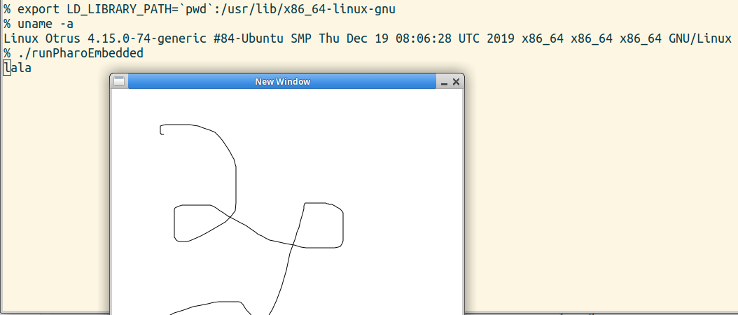Embedding Pharo in Pascal HOWTO - Linux
Pharo headless VM
First, build the Pharo headless
VM, following the instructions in
its README. When done, the VM files are in build/vm.
Pharo application image
Next, prepare the Pharo application image. Basically, start from a fresh Pharo 8.0 image and
load the EmbeddedSupport code from Pablo's repository. The following snippet works,
assuming you have cloned Pablo's repository locally; adjust the gitlocal path in the snippet,
of course.
Metacello new
baseline: 'EmbeddedSupport';
repository: 'gitlocal:///home/pierce/src/st/pharo-vm-embedded-example/smalltalk-src';
load.
NoChangesLog install.
NoPharoFilesOpener install.
PharoCommandLineHandler forcePreferencesOmission: true.
SmalltalkImage current snapshot: true andQuit: true
Windows resource
Then, embed the Pharo application image into a Windows resource file.
Here's a simplified version of resources.rc. This assumes you have named the image to be
embedded Pharo.image.
300 RCDATA "Pharo.image"
Building a Windows resource file on Linux requires windres. On Ubuntu, this program is
part of the package binutils-mingw-w64-x86-64.
Place the application Pharo.image and resources.rc in the same
directory. Then,
% /usr/bin/x86_64-w64-mingw32-windres -i resources.rc -o resources.res
% ls -l
total 113488
-rw-r--r-- 2 pierce pierce 58098672 Jan 23 14:10 Pharo.image
-rw-r--r-- 2 pierce pierce 25 Jan 23 14:01 resources.rc
-rw-r--r-- 2 pierce pierce 58098736 Jan 23 14:10 resources.res
The output resources.res is the compiled resources file.
Pascal host program
Finally we are ready to build the Pascal host program. Move resources.res to this
repository's embedded-cli directory. Also create a link to libPharoVMCore.so or make
a copy of it. The directory's content is now as follows:
% ls -l
total 58736
-rwxr-xr-x 2 pierce pierce 3344760 Jan 23 09:26 libPharoVMCore.so*
-rw-r--r-- 2 pierce pierce 58098736 Jan 23 14:10 resources.res
-rw-r--r-- 4 pierce pierce 1945 Jan 23 12:55 runPharoEmbedded.pas
-rw-r--r-- 4 pierce pierce 3824 Jan 23 12:54 ulibEmbeddedImage.pas
-rw-r--r-- 5 pierce pierce 1045 Jan 22 15:42 ulibPharoVM.pas
At the start of runPharoEmbedded.pas, the line
{$R resources.res} is the Pascal compiler directive to incorporate resources.res into the
executable that is being built:
program runPharoEmbedded;
{$mode objfpc}{$H+}
{$R resources.res} { <= compiler directive to incorporate resources.res }
{$linklib m}
Build the host program - the Pascal compiler is its own make system and knows to compile
the necessary source files. (The Pascal compiler also knows how to invoke windres to
compile resources.rc into resources.res when so configured. I've done that part by
hand since this is a HOWTO.)
% fpc runPharoEmbedded.pas
Free Pascal Compiler version 3.0.4 [2018/10/29] for x86_64
Copyright (c) 1993-2017 by Florian Klaempfl and others
Target OS: Linux for x86-64
Compiling runPharoEmbedded.pas
Compiling ulibPharoVM.pas
Compiling ulibEmbeddedImage.pas
Compiling resource runPharoEmbedded.or
Linking runPharoEmbedded
/usr/bin/ld: warning: link.res contains output sections; did you forget -T?
232 lines compiled, 0.4 sec
% ls -l runPharoEmbedded
-rwxr-xr-x 1 pierce pierce 58884328 Jan 23 14:22 runPharoEmbedded*
Much of the size of the executable is due to the embedded Pharo.image.
We'll run runPharoEmbedded in the headless VM build directory because Pharo's
baked-in library lookup currently requires this. (More on this in a later post.) So move the
program over.
% mv runPharoEmbedded ~/src/st/opensmalltalk-vm-pharo/build/vm
% cd ~/src/st/opensmalltalk-vm-pharo/build/vm
% ls -T 30
libB2DPlugin.so* libgit2.so.0.25.1 libSDL2-2.0.so.0* libssl.so*
libBitBltPlugin.so* libgit2.so.25 libSDL2-2.0.so.0.7.0* libssl.so.1.0.0*
libcrypto.so.1.0.0* libIA32ABI.so* libSDL2.so* libSurfacePlugin.so*
libDSAPrims.so* libJPEGReaderPlugin.so* libSecurityPlugin.so* libTestLibrary.so*
libffi.so* libJPEGReadWriter2Plugin.so* libSocketPlugin.so* libUnixOSProcessPlugin.so*
libffi.so.7* libLargeIntegers.so* libSqueakFFIPrims.so* libUUIDPlugin.so*
libffi.so.7.1.0* libLocalePlugin.so* libSqueakSSL.so* pharo*
libFileAttributesPlugin.so* libMiscPrimitivePlugin.so* libssh2.so* runPharoEmbedded*
libFilePlugin.so* libPharoVMCore.so* libssh2.so.1*
libgit2.so libPThreadedPlugin.so* libssh2.so.1.0.1*
Set up LD_LIBRARY_PATH. The first path segment is for the Pharo VM. The second is for
libcairo2.so needed by the embedded Pharo.image - on Ubuntu, it lives in
/usr/lib/x86_64-linux-gnu, which isn't in Pharo 8's current hardcoded lookup path. Then
run the executable:
% export LD_LIBRARY_PATH=`pwd`:/usr/lib/x86_64-linux-gnu
% uname -a
Linux Otrus 4.15.0-74-generic #84-Ubuntu SMP Thu Dec 19 08:06:28 UTC 2019 x86_64 x86_64 x86_64 GNU/Linux
% ./runPharoEmbedded
lala

Ta da! "lala" is printed by Pharo.
Tags: embedded, FFI, headless, PascalCross Platform Embedded Pharo
Recently Pablo Tesone published an example of embedding a Pharo image as a Windows resource inside a program written in C.
Well, the excellent and, like Smalltalk, vastly underrated Free Pascal programming system has cross-platform support for handling Windows resources. With it, I have reimplemented Pablo's example: One source code building executables that run on Ubuntu 18.04 and MacOS Mojave. Not tested on Windows yet, but I'm sure it'll work there too. The three Pascal source files, including blank lines and comments, total 209 lines:
-
ulibPharoVM.pas, FFI tolibPharoVMCore, comprising one data type and two functions. -
ulibEmbeddedImage.pas, implementing the functions called bylibPharoVMCoreto access the Pharo image that is embedded as a Windows resource. -
runPharoEmbedded.pas, the main program which is pretty much a straight port of Pablo's C program.
Repository on GH. More details to come.
Tags: embedded, FFI, headless, PascalPharo Headless Interactive RFB
In deployment war stories, I wrote that Pharo's graphical environment is managed by MorphicUIManager, but when invoked -nodisplay, Pharo's graphical environment is managed by NonInteractiveUIManager.
I prefer running my servers without X as far as possible, so I want to have RFBServer running within the Pharo image, to be able to VNC into it.
As it turns out, modifying one method, MorphicUIManager>>onSnapshot:, gets me what I want. Here's what the method looks like in Pharo 1.4, timestamped CamilloBruni 2/13/2012 23:22, (minus comments because I don't like the way the Smalltalk syntax highlighting JS library I'm using is rendering them):
onSnapshot: resuming
resuming ifTrue: [
Smalltalk isInteractive ifFalse: [
^ self nonInteractiveManager onSnapshot: resuming ].
Smalltalk isHeadless ifTrue: [
^ self headlessManager onSnapshot: resuming ]].
SystemWindow wakeUpTopWindowUponStartup
I just needed to add tests for RFBServer, so now the method becomes like this:
onSnapshot: resuming
resuming ifTrue: [
Smalltalk isInteractive ifFalse: [
RFBServer server isRunning ifFalse: [
^ self nonInteractiveManager onSnapshot: resuming ]].
Smalltalk isHeadless ifTrue: [
RFBServer server isRunning ifFalse: [
^ self headlessManager onSnapshot: resuming ]]].
SystemWindow wakeUpTopWindowUponStartup
And now VNC into the Pharo image works, yay!
Tags: deployment, headless, RFB, VNC